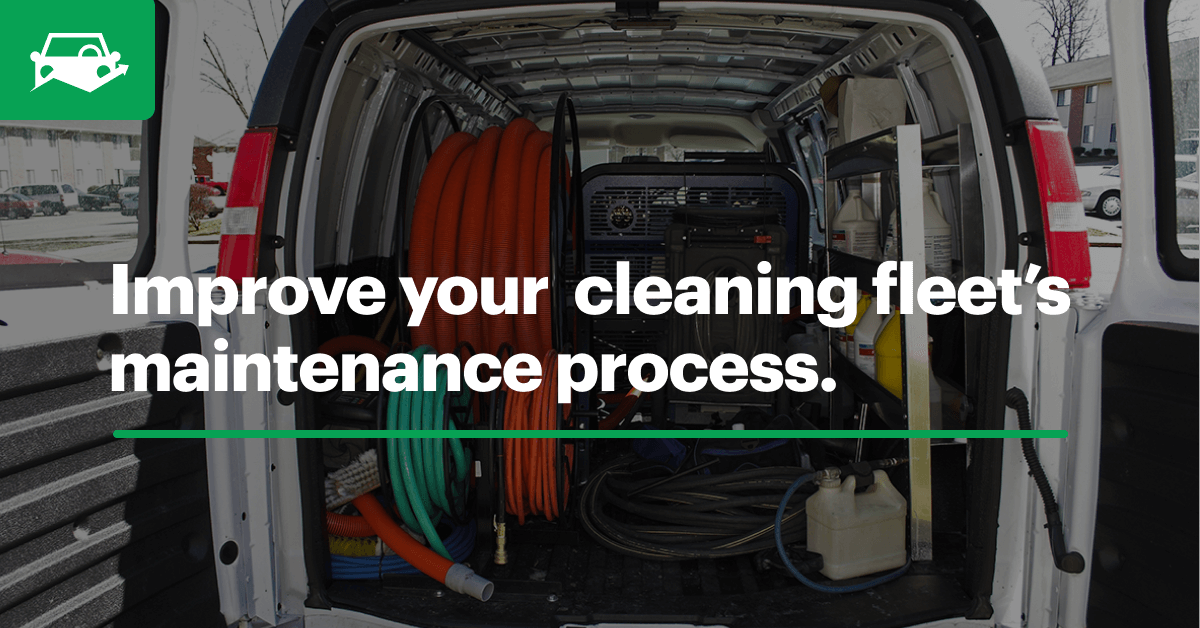With such a wide variety of truck sizes, uses and types, developing a truck fleet maintenance plan is a massive undertaking. Whether you operate a fleet of light-duty service pick-ups or Class 8 big rigs, an effective maintenance process allows you to hammer down on inefficiencies and reduce asset downtime.

Developing a Truck Fleet Maintenance Strategy
Two of the top priorities of your truck fleet maintenance management plan should be to prevent downtime and lengthen asset lifespan. This not only ensures you’re providing the best service possible to your customers, but you’re also maximizing the return on investment for your expensive assets.
Many fleet managers are turning to a cloud-based software solution to track every aspect of their fleet, including maintenance tasks, team productivity and expenses. Managing your truck fleet maintenance in a centralized software provides maximum visibility into asset health and allows you to instantly communicate maintenance needs across your team.
When developing your truck fleet maintenance strategy, take into account your fleet’s particular needs. Smaller trucks will need a different maintenance plan from larger or specialized trucks. Here, we’ve broken down truck fleet maintenance into three categories to help you determine the best course of action for your fleet.
- Truck Fleet Maintenance for Light-Duty Vehicles
- Fleet Maintenance Practices for Medium and Heavy Duty Trucks
- Planning Maintenance for Specialized and Upfitted Trucks
Truck Fleet Maintenance for Light-Duty Vehicles
Light-duty trucks have a gross vehicle weight rating (GVWR) of up to 8,500 pounds, making them ideal for service fleets, like landscaping or plumbing, who often drive in suburban areas. Light-duty fleets typically consist of pick-up trucks or vans, though some fleets, like personal transportation fleets, may include sports utility vehicles.
Light duty truck fleet maintenance plans should put a premium on vehicle inspections and preventive maintenance. Taking a proactive stance on maintenance ensures your vehicles are ready when you need them and remain reliable along their daily route.
Standardizing Vehicle Inspections
Monitoring asset health can be challenging if your team doesn’t complete routine vehicle inspections. Small issues under the hood can often go undetected and lead to larger issues and breakdowns in the long run.
Having drivers complete daily vehicle inspections ensures all issues are documented and maintenance can be expedited. The most efficient way drivers can complete inspections is by leveraging a mobile inspection app.
With your fleet constantly on the move, a mobile inspection app allows your drivers to perform inspections anywhere in the field and instantly upload results into your fleet management software. Any issues are immediately emailed to you, allowing you to determine the best course of action regarding maintenance.
Keeping Up with Preventive Maintenance
The best truck fleet maintenance plans are proactive, not reactive. This means your team consistently performs preventive maintenance in accordance with the manufacturer’s recommendations.
Adhering to a preventive maintenance schedule can be a challenge for fleets that still use paper calendars and spreadsheets to manage maintenance. To get your vehicle in the shop for routine maintenance on time, fleet management software sends service reminders to your inbox based on odometer readings on engine hour intervals.
Drivers can update odometer readings in the mobile inspection app, or you can integrate your telematics system into fleet management software to automatically receive odometer updates. Automating maintenance reminders with the help of software ensures your truck fleet never misses scheduled service.
Fleet Maintenance Practices for Medium and Heavy Duty Trucks
Medium to heavy-duty truck fleets are often used for deliveries, making uptime extremely important. Automating truck fleet maintenance processes and maximizing asset visibility are two of the best strategies for maintaining your fleet’s safety and reliability.
Maintaining Compliance with Daily Vehicle Inspection Reports
Daily Vehicle Inspection Reports (DVIR) are required for commercial vehicles by the Department of Transportation (DOT). Completing and maintaining a record of DVIRs keeps your fleet in compliance with DOT regulations and ensures your trucks stay safe on the road.
Paper DVIR forms are time-consuming for truckers. To get back to their routes, some drivers pencil-whip from the driver’s seat, and potentially miss critical issues under the hood.
Electronic DVIR (eDVIR) empowers drivers to complete fast, thorough inspections via a mobile app. All inspection data is housed in cloud-based software. Not only does this allow drivers to prove compliance on the highway, but eDVIR also instantly alerts fleet managers of any potential issues. Even if an asset is hundreds of miles away, you can quickly develop a truck fleet maintenance plan and direct your driver to a local shop for repairs.
Tracking Vehicles with Telematics
Whether your trucking fleet stays local or your drivers operate on regional or national routes, gaining visibility into your operations can be a challenge if you’re still using antiquated systems to manage your fleet.
Many trucking fleets use GPS or telematics devices to track and manage routes, but these tools can also offer excellent insight into the health of your assets. Pairing your telematics device with fleet management software provides maximum visibility across your fleet and provides real-time data regarding vehicle health and safety.
Leveraging telematics data augments your truck fleet maintenance strategy by providing insight into diagnostic trouble codes (DTC) to alert you of any underlying maintenance issues. Tracking telematics data alongside all other fleet data gives you a complete picture of your fleet’s health and productivity.
Automating Maintenance Workflows
Truck fleet maintenance can be automated to streamline processes and get your vehicles in and out of the shop quickly. From receiving service reminders for upcoming preventive maintenance to viewing work order status in real time, fleet management software helps you reduce downtime by creating workflows that suit your fleet.
Tracking work orders with software gives you a comprehensive line item breakdown, enabling you to view issues, track technician productivity and monitor repair expenses. Whether you manage maintenance in house or outsource to a third party, you can avoid surprise line items and control expenses to stay within your budget.
Planning Maintenance for Specialized and Upfitted Trucks
Outside of more conventional trucks, many fleets operate specialized assets that are designed for specific purposes, like [waste management or utility trucks. Each of these come with their own challenges regarding maintenance and tracking, so developing truck fleet maintenance strategies that make sense for your fleet is imperative.
Leveraging configurable fleet management software allows you to create systems and workflows that maximize the efficiency of your specialized assets. Fleet managers have complete control of how they manage their assets and gain maximum visibility throughout their operation.
Tailoring Inspection Forms
Whether your trucks are upfitted or have special features, traditional paper inspection forms don’t work for your fleet, as they leave off important aspects that must be inspected for safety. Using fleet management software to manage inspections allows you to customize your inspection forms to include items like:
- Winches
- Toolboxes
- Cranes
- Shelving
- Ladder racks
- Hoppers
- Packer blades
Including these items in your vehicle inspection process allows your operators to quickly identify issues and communicate them with you to avoid compounding issues and unnecessary downtime.
Optimizing Maintenance Schedules
Because specialized assets are so expensive, you often don’t have back-up vehicles if breakdowns occur. This can be a problem for fleets that don’t have the luxury of a flexible schedule. Handling truck fleet maintenance efficiently is important to maintaining uptime and avoiding serious issues on your routes.
Along with automating service reminders for preventive maintenance, fleet managers must carefully schedule maintenance to avoid conflicting with the workday. For waste management fleets, this may mean scheduling all maintenance in the afternoon or evening. Utility fleets may need to take the weather into account, as strong storms may cause your fleet to be busier than usual.
As a fleet manager, you must oversee every aspect of the maintenance process. Fleet management software empowers you to manage all maintenance activity in real time, schedule repairs efficiently and track all expenses and service history to make the best decisions for your fleet’s future.
Fleetio helps trucks of all shapes and sizes maximize efficiency and improve workflows! Start your free trial or request a demo today.




